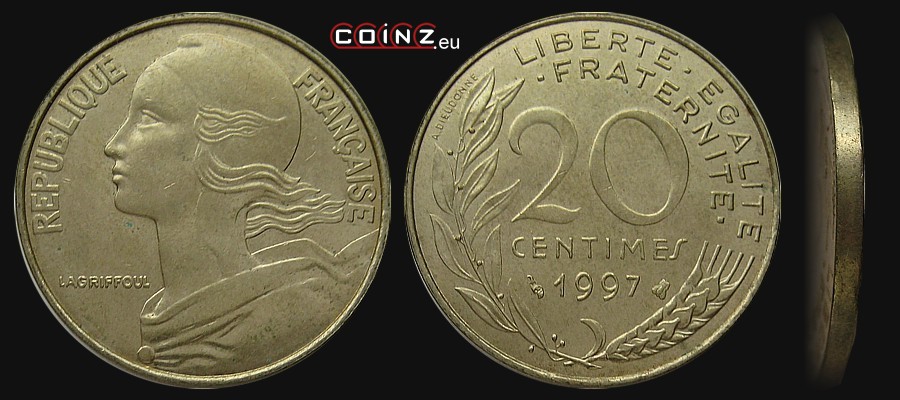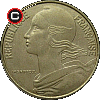20 centimes FRANCE (1962-2001)


| diameter: | weight: | thickness: | alloy: |
| 23.5 mm | 4.0 g | 1.5 mm | Cu92Al6Ni2 |
obverse:
in the coin centre personification of France - bust of Marianne in a Phrygian cap facing left; along the top edge: RÉPUBLIQUE FRANÇAISE (French Republic)
reverse:
in the coin centre in two lines large face value: 20 / CENTIMES; below year of issue; along the bottom edge wreath of the laurel branch on the left and cereal ear on the right; along the top right edge in two lines motto of France: LIBERTE • EGALITE / • FRATERNITE • (liberty, equality, fraternity)
edge:
plain
issue date:
13 XI 1961
withdrawal date:
18 II 2002
designer:
Henri Lagriffoul (signature LAGRIFFOUL at Marianne's neck in the obverse), Adrien Dieudonné (signature A.DIEUDONNE before LIBERTE along the reverse edge)
mint:
 La Monnaie de Paris (The Paris Mint), Paris (until 1972) or Pessac (from 1973) (mint mark on the left side of the face value in the reverse, on the right side of the face value privy mark of mint's director Raymond Joly - owl - in years 1965-1974, Emile Rousseau - dolphin - in years 1975-1994, Pierre Rodier - bee - in years 1994-2000 or Gérard Buquoy - horseshoe - in 2001)
La Monnaie de Paris (The Paris Mint), Paris (until 1972) or Pessac (from 1973) (mint mark on the left side of the face value in the reverse, on the right side of the face value privy mark of mint's director Raymond Joly - owl - in years 1965-1974, Emile Rousseau - dolphin - in years 1975-1994, Pierre Rodier - bee - in years 1994-2000 or Gérard Buquoy - horseshoe - in 2001)

mintage:
| 1962 | 48 200 000 | owl | |
| 1963 | 190 330 000 | owl | |
| 1964 | 127 521 000 | owl | + 25 600 in annual boxed sets |
| 1965 | 27 024 000 | owl | + 35 000 in annual boxed sets |
| 1966 | 21 755 000 | owl | + 7 171 in annual boxed sets |
| 1967 | 138 780 000 | owl | + 2 305 in annual boxed sets |
| 1968 | 77 408 000 | owl | + 3 000 in annual boxed sets |
| 1969 | 50 570 000 | owl | + 6 050 in annual boxed sets |
| 1970 | 70 040 000 | owl | + 10 000 in annual boxed sets |
| 1971 | 31 080 000 | owl | + 12 000 in annual boxed sets |
| 1972 | 39 740 000 | owl | + 15 000 in annual boxed sets |
| 1973 | 45 240 000 | owl | + 79 000 in annual boxed sets |
| 1974 | 54 250 011 | owl | + 98 800 in annual boxed sets |
| 1975 | 40 570 011 | dolphin | + 52 000 in annual boxed sets |
| 1976 | 117 340 211 | dolphin | + 37 500 in annual boxed sets |
| 1977 | 100 340 011 | dolphin | + 25 000 in annual boxed sets |
| 1978 | 125 015 011 | dolphin | + 24 000 in annual boxed sets |
| 1979 | 70 000 011 | dolphin | + 40 500 in annual boxed sets |
| 1980 | 19 950 011 | dolphin | + 60 000 in annual boxed sets |
| 1981 | 124 974 011 | dolphin | + 26 000 in annual boxed sets |
| 1982 | 149 975 011 | dolphin | + 27 500 in annual boxed sets |
| 1983 | 109 984 411 | dolphin | + 16 561 in annual boxed sets |
| 1984 | 199 986 611 | dolphin | + 13 836 in annual boxed sets |
| 1985 | 149 990 011 | dolphin | + 12 500 in annual boxed sets |
| 1986 | 39 985 011 | dolphin | + 15 000 in annual boxed sets |
| 1987 | 59 985 011 | dolphin | + 11 956 in annual boxed sets |
| 1988 | 223 220 011 | dolphin | + 10 565 in annual boxed sets |
| 1989 | 139 985 011 | dolphin | + 11 438 in annual boxed sets |
| 1990 | 49 990 011 | dolphin | + 10 000 in annual boxed sets |
| 1991 | 39 990 011 | dolphin | + 2 500 in annual boxed sets |
| 1992 | 89 965 011 | dolphin | + 2 698 in annual boxed sets |
| 1993 | 109 970 011 | dolphin | + 3 095 in annual boxed sets |
| 1994 | 60 000 000 | dolphin | |
| 1994 | 79 969 661 | bee | + 3 707 in annual boxed sets |
| 1995 | 109 975 011 | bee | + 4 000 in annual boxed sets |
| 1996 | 139 979 013 | bee | + 5 000 in annual boxed sets |
| 1997 | 436 216 513 | bee | + 15 000 in annual boxed sets |
| 1998 | - | bee | + 25 000 in annual boxed sets |
| 1999 | - | bee | + 25 000 in annual boxed sets |
| 2000 | 83 385 013 | bee | + 101 000 in annual boxed sets |
| 2001 | - | horseshoe | + 125 000 in annual boxed sets |
varieties:
In years 1991, 1992 and 1993 there exist coins with reverses not rotated by 180° in respect to obverses (medal alignment in American terminology) - 2500, 2698 and 3095 pieces were produced in respective years and placed in annual boxed sets;
1994 - coins with a privy mark of mint's director Emile Rousseau dolphin or with the privy mark of Pierre Rodier bee

1994 - coins with a privy mark of mint's director Emile Rousseau dolphin or with the privy mark of Pierre Rodier bee

mint marks:
interesting facts:
last update: 20 XI 2013
coins catalogue :: katalog monet :: münzkatalog :: catalogue de monnaies :: catálogo de monedas :: catalogo monete :: каталог монет :: κέρματα κατάλογος :: COINZ.eu
© 2010-2025 :: Adam Kubicki :: COINZ.eu :: All rights reserved.


